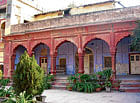
Age has not been able to wither the alma mater of Sir Syed Ahmed Khan, eminent educationist and founder of Aligarh Muslim University; Liaqat Ali Khan, Pakistan’s first prime minister; Maulana Mohammed Hussain Azad, father of Urdu prose; Deputy Nazir Ahmed, Urdu essayist and ICS; Akhtar-ul-Iman, a great poet; Mirza MN Masood, Indian hockey Olympian and many more. Delhi’s Anglo Arabic School that began in 1696 as Madrasa Ghaziuddin Khan, has survived nearly 300 years as an institution of learning.
Opened by Ghaziuddin Khan, an influential courtier and brave general of the Mughal emperor Aurangzeb, the seminary has been serving the cause of education under the labels of Madrasa Ghaziuddin Khan, Anglo Arabic School, Anglo Arabic College, Delhi College and Zakir Hussain College for centuries. This school now imparts education to the children of the walled city of Delhi. “As an institution of learning, Anglo Arabic School has been a mute witness to the chequered history of the city, including the two famous wars of independence of 1758 and 1857. The building remained unscathed and the imposing Kota sandstone structure successfully evolved into a centre of secular as well as theological learning,” remarks a nostalgic Pankaj Vohra, an old boy of the institution and the associate editor of Hindustan Times.
The elegant building consists of a large enclosure of arched apartments with a gate on the east and a three-domed mosque on the west with an enclosure of perforated stone screens both on the latter’s north as well as south. Domes with octagonal towers against a backdrop of beautiful jharokas (parlours) and engravings give a majestic view to the entire surroundings. Inside, there are two hujras (corridors) meant to be used as dormitories for the madrasa students of yore. In the centre of the entire complex, there is a park with plush green grass.
Until 1827, this madrasa was a religious seminary but after the interference of the East India Company, it was Sir Charles Metcalfe who also started the education of English, mathematics and natural sciences. The marble tablet on the chemistry lab of the school says: “Etemad-ud-Daula, Zia-ul-Mulk, Syed Fazal Ali Khan Bahadur Sahab Jung gave Rs 1.70 lakh for the propagation of this institution and gave it in the trust of the Company Bahadur in 1829.” In 1840, the institution was shifted to the Darah Shikoh (Shahjahan’s son) Library at Kashmiri Gate. During the Sepoy Mutiny of 1857, it remained closed for seven years and reopened only in 1867. At that time the English christened it as Anglo Arabic College that later turned into Delhi College. It is amazing just how the same premises gave rise to so many forms of temples of learning of which two are still full-fledged institutions.
The most important literary activity in the history of the school was the formation of the Vernacular Translation Society in 1832. As Urdu was the medium of instruction, students could not avail of the variety found in English, German, French, algebra, social and natural sciences.
These were translated in Urdu. Some of the scholars on job included literary luminaries of the time like Master Pyarey Lal, Imam Bakhsh Suhbai, Lala Dharam Narain and brother Prem Narain, Maulana Zakaullah, Taylor, Butros and others. During the 1830s and 40s, the college had really been at the pinnacle of its pristine glory and was considered to be the centre of Asian ‘renaissance’ as not only Indians but even some of the English too were its students, according to its present vice principal Abdul Malik!
Some time ago, the encroachments — 51 families living in the school premises and classrooms — were removed after a PIL was filed by the Friends for Education, a platform for the uplift of education, civic sense and cultural heritage.
This is the only school in the walled city of Delhi that has a playground and whose football team has won the zonals time and again. The school also awaits a sum of Rs 1.25 crore from the Delhi governor AR Kidwai for its restoration that was left incomplete by the DDA.
Sadly though, the hostel of Zakir Hussain College still encroaches upon the land of Anglo Arabic School despite the High Court orders that it be removed forthwith. Space is needed for the already beleaguered sections of the walled city of Delhi.
The real architectural sanctity of the monument comes to the beholder’s eyes once he enters Masjid Nawab Ghaziuddin Khan that is skillfully built with red Kota sandstone. The students of the school pray here in the afternoon.
Once the mosque had a well and a tank connected to it for the purpose of wuzu (ablutions). There is also a mazaar (shrine) of a saint in the northern side of the mosque. The school suffered during the Sepoy Mutiny when the science laboratories and the library were burnt and along with that umpteen priceless manuscripts turned to ashes.
But that did not mar the pristine glory of the institution as it has generations of students who have made their mark as leaders in various walks of life, including Khwaja Ahmed Farooqui (litterateur), Jaan Nisar Akhtar (eminent poet) Prof AN Kaul (pro-vice chancellor Delhi University), Dharam Narayan and Prem Narayan (Persian scholars), Master Ram Chander, Master Pyare Lal (eminent Persian scholars), JN Dixit (defence analyst), Prof Gopi Chand Narang (world renowned Urdu/ Persian critic), BN Uniyal, Shahid Siddiqui, Man Mohan, Noor Jahan Sarwat, Mukul Vyas, Chandra Prabha, Ziya Us Salam, and Habib Akhtar (all eminent journalists) and lastly — politicians like Jagdish Tytler, Sikandar Bakht, Harsh Vardhan, M Afzal.